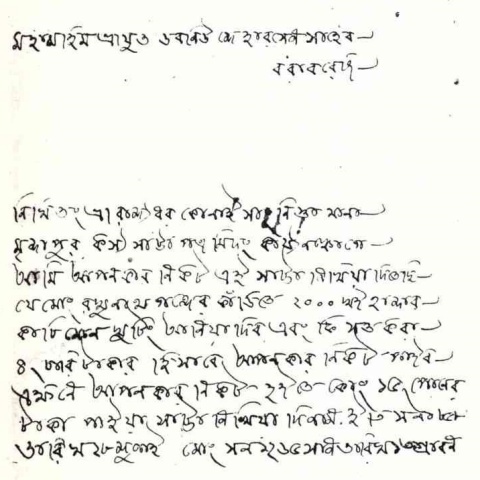 Contract for 2,000 maunds of road-metalling, between W. J. Herschel
and Rajyadhar Konai, in Konai's handwriting
Contract for 2,000 maunds of road-metalling, between W. J. Herschel
and Rajyadhar Konai, in Konai's handwriting
Project Gutenberg's The Origin of Finger-Printing, by William J. Herschel This eBook is for the use of anyone anywhere at no cost and with almost no restrictions whatsoever. You may copy it, give it away or re-use it under the terms of the Project Gutenberg License included with this eBook or online at www.gutenberg.org Title: The Origin of Finger-Printing Author: William J. Herschel Release Date: January 5, 2011 [EBook #34859] Language: English Character set encoding: ISO-8859-1 *** START OF THIS PROJECT GUTENBERG EBOOK THE ORIGIN OF FINGER-PRINTING *** Produced by Eric Hutton and the Online Distributed Proofreading Team at http://www.pgdp.net
Commissioner of the Metropolitan Police.
I am offering you this old story of the beginnings of Finger-printing, by way of expressing my warm and continuous admiration of those masterly developments of its original applications, whereby, first in Bengal and the Transvaal, and then in England, you have fashioned a weapon of penetrating certainty for the sterner needs of Justice.
June, 1916.
The following pages have two objects: first, to place on record the genesis of the Finger-print method of personal identification, from its discovery in Bengal in 1858, till its public demonstration there in 1877-8; secondly, to examine the scanty suggestions of evidence that this use of our fingers had been foreshadowed in Europe more than a hundred years ago, and had indeed been general in ancient times, especially in China.
In later years, and in energetic hands, the method has been developed into a system far more effective than anything I contemplated, and I do not go into that part of the story; but I believe these pages will suffice to show the originality of my study of its two essential features, the strict individuality and the stubborn persistence of the patterns on our fingers.
The gift granted to me of lighting upon a discovery which promised escape from one great difficulty of administration in India is more than ever appreciated by me since I have lived to see the promise wonderfully fulfilled there, and in other lands as well.
For the sake of interest I give, among the illustrations, several examples of late 'repeats' taken many years after I left India; but these do not belong to my story.
| PAGE | |
| Bengalee contract with Rājyadhar Kōnāi, 1858. (Collotype) | Between pages 8 and 9 |
| Finger-print of Dr. R. F. Hutchinson, Medical Officer at Arrah Station, June 1859 | 10 |
| Finger-print of Captain H. Raban, Chief of the Police in Lower Bengal, July 29,1860 | 12 |
| Finger-print of the Mahārājā of Nuddea, April 13, 1862 | 13 |
| Finger-print of Sir Charles Howard, Superintendent of Police, Nuddea, April 13, 1862; and repeat, 1908 | 13 |
| Finger-print of Sir Alfred C. Lyall, 1877; and repeat, 1908 | 17 |
| Finger-print of Captain A. Coleman, P. & O. SS. 'Mongolia', February 1877 | 17 |
| Finger-prints of Bechā Rām Dās Adhikāri, (a) made in 1877, (b) made in 1892 | 21 |
| Finger-print of W. F. Courthope, 1877; and repeat, 1913 | 27 |
| Finger-print of Captain V. H. Haggard, R.N., 1877, aet. 2¾ years; and repeat, 1913. (Collotype) | Facing 27 |
| Finger-print of Colonel J. Herschel, R.E., September 22, 1877 | 28 |
| Finger-print of Dr. J. F. Duthie, September 22, 1877 | 28 |
| Finger-print of Sir Theodore Hope, Bo.C.S., 1877 | 29 |
| Finger-prints of William Waterfield, B.C.S., (a) July 31, 1860, (b) March 31, 1877 | 29 |
| Finger-prints of W. J. Herschel, (a) June 1859, (b) July 1859, (c) March 31, 1877, (d) February 22, 1916 | 30 |
| Finger-prints, enlarged, of A. E. H. Herschel: 1881, aet. 7¾; 1890, aet. 17; 1913, aet. 40 | 31 |
| 'Thomas Bewick his mark' | 33 |
| A 'tep-sai' of Bengal compared with a finger-print | 35 |
| Caste-marks of illiterates, 1865 | 36 |
| Finger-mark on a Chinese Bank-note. (Collotype) | Facing 38 |
In 1858, after five years' service, as an Assistant under the old East India Company, in the interior of Bengal, I was in charge of my first subdivision, the head-quarters of which were then at Jungipoor, on the upper reaches of the Hooghly river. My executive and magisterial experience had by that time forced on me that distrust of all evidence tendered in Court which did so much to cloud our faith in the people around us. We cannot be too thankful that things have greatly improved in India in the last sixty years, but the time of which I am speaking was the very worst time of my life in this respect. I remember only too well writing in great despondency to one of the best and soberest-minded of my senior companions at Haileybury[1] about my despair of any good coming from orders and decisions based on such slippery facts, and the comfort I found in his sensible reply.[Pg 8]
 Contract for 2,000 maunds of road-metalling, between W. J. Herschel
and Rajyadhar Konai, in Konai's handwriting
Contract for 2,000 maunds of road-metalling, between W. J. Herschel
and Rajyadhar Konai, in Konai's handwriting
It happened, in July of that year, that I was starting the first bit of road metalling at Jungipoor, and invited tenders for a supply of 'ghooting' (a good binding material for light roads). A native named Rājyadhar Kōnāi, of the village of Nistā, came to terms with me, and at my desire drew up our agreement in his own hand, in true commercial style. He was about to sign it in the usual way, at the upper right-hand corner, when I stopped him in order to read it myself; and it then occurred to me to try an experiment by taking the stamp of his hand, by way of signature instead of writing. There was nothing very original about that, as an idea. Many must have heard of some such use of a man's hand; and the correspondence that has taken place has brought to light old instances of the hand, or the nail of a finger, or the teeth in one's mouth, being used to certify a man's act, or a woman's. But these have all been isolated instances. Sir Francis Galton, however, has pointed out[2] that in our own times the engraver Bewick had a fancy for engraving his thumb-mark, with his name attached, as vignettes, or as colophons, in books which he published.[3] As a boy I had loved Bewick on Birds: I regret that it is not now to be found in our library. Galton's remark has reminded me that I used to see the thumb-mark there, as well as I recollect, in an ornamental title-page. I mention this because I dare say it had something to do with my fascination over Kōnāi's hand-markings. If so, the influence was unknown to me. The absorbing interests of manhood had blotted out, not Bewick, but his thumb-mark, from my memory. However that may be, I was only wishing to frighten Kōnāi out of all thought of repudiating his signature hereafter. He, of course, had never dreamt of such an attestation, but fell in readily enough. I dabbed his palm and fingers over with the home-made oil-ink used [Pg 9] for my official seal, and pressed the whole hand on the back of the contract, and we studied it together, with a good deal of chaff about palmistry, comparing his palm with mine on another impression. Here is a facsimile of the whole document, made by the Clarendon Press. I was so pleased with the experiment that, having to make a second contract with Kōnāi, I made him attest it in the same way. One of these contracts I gave to Sir Francis (then Mr.) Galton for his celebrated paper read before the Royal Society, November 1890, to which body he presented it; the other lies before me now. Trials with my own fingers soon showed the advantage of using them instead of the whole hand for the purpose then in view, i.e. for securing a signature which the writer would obviously hesitate to disown. That he might be infallibly convicted of perjury, if he did, is a very different matter. That was not settled, and could not have been settled, to the satisfaction of Courts of Justice, till, after many years, abundant agreement had been reached among ordinary people. The very possibility of such a 'sanction' (to use a technical expression) to the use of a finger-print did not dawn upon me till after long experience, and even then it became no more than a personal conviction for many years more. The decisiveness of a finger-print is now one of the most powerful aids to Justice. Our possession of it derives from the impression of Kōnāi's hand in 1858.
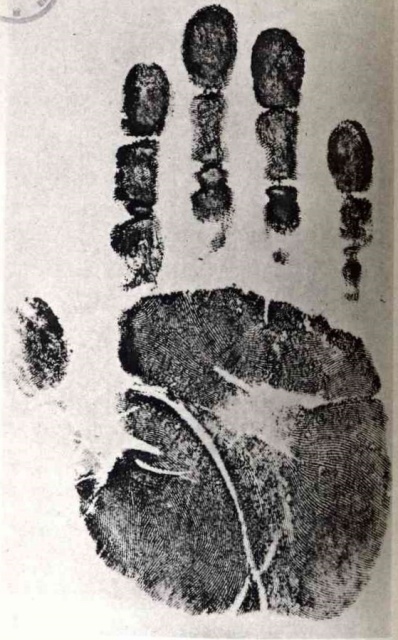 KONAI'S HAND
KONAI'S HANDOf trials with my own fingers the oldest impression [Pg 10] I possess was taken in June 1859, when I first began to keep records. I had been transferred to be Magistrate of Arrah, the most north-westerly district of Bengal, where the Mutiny still left work to do which allowed little time for private hobbies; but I took so many prints among the society of the Station, as well as among Indians of all classes, that my 'fad' about them was well known. The Medical Officer of Arrah was Dr. R. F. Hutchinson, who naturally took great interest in the subject. Twenty-one years later, in 1880, he was still there, and sent me a 'repeat' print of his fingers. Here is a facsimile of his first Arrah impression. In 1890, being in England, he visited Galton's Laboratory, and gave a second repeat (after thirty-one years) which was used in 'Finger-prints' (1892), p. 93, to support Mr. Galton's evidence of 'Persistency'. In the facsimile 'Collection 1858-1913', which I am attaching to some of the copies of this narrative, will be found other prints which I took at Arrah of my whole hand and of my right foot. They agree irresistibly with prints taken now after an interval of fifty-seven years.
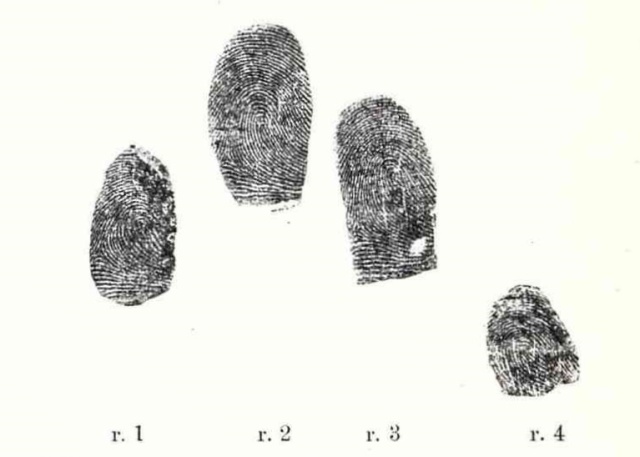 R. F. Hutchinson, June 1859, Medical Officer at Arrah Station.
R. F. Hutchinson, June 1859, Medical Officer at Arrah Station.
In 1860 I was sent as Magistrate to Nuddea, nearer to Calcutta. The Indigo disturbances in the district had given rise to a great deal of violence, litigation, and fraud; forgery and perjury were rampant. The rent-rolls of the ryots put into Court by the Zemindars; the pottahs (agreements for rent) purporting to be issued by them to each ryot, put in by the latter; the kabooliyats (acceptances) purporting to be signed by the ryot, and tendered in evidence against him; all these documents were frequently worth no more than the paper on which they were written. In my own jail a notorious convict was found making clay seals of well-known landlords, and forging their signatures on pottahs smuggled into his hands. He was detected by the colour of the floor of his cell, where he kept his stock-in-trade buried. Things were so bad in this and other ways that the administration of Civil Justice had unusual difficulty in preserving its dignity. I was driven to take up finger-prints now with a definite object before me, and for three years continued taking a very large number from all sorts and conditions of men. I give here some selected impressions of friends taken in Nuddea during the years 1860, 1861, and 1862, in order of date, and names of some others.
1860, July. Claude Brown, a prominent merchant of Calcutta, who was making a tour in the Indigo districts, and was at the time my guest.
1860, July 29. Captain H. Raban, Head of the Bengal Police, sent to Nuddea on account of its disturbed state; also my guest. He took extreme interest in the evidence of his own imprint. It was my habit, of course, to give duplicates of his 'mark' to every one of importance.
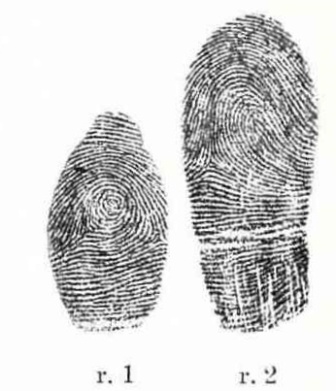 Captain H. Raban, Head of the Police in Lower Bengal, July 29, 1860.
Captain H. Raban, Head of the Police in Lower Bengal, July 29, 1860.
1860, July 31. W. Waterfield, B.C.S., a college friend, afterwards Comptroller-General of the Treasuries of India. I have several 'repeats' of his; see especially p. 29.
1861, June 24. Ogilvie Temple, Judge of the Court of Small Causes, Kooshtea.
1862, April 13. At a gathering at my house at Kishnagar I had the good fortune to secure the prints of many other notables of the district.
The Mahārājā of Nuddea. He was the highest of the old nobility of Bengal. He was much struck,[Pg 13] as I was, by the remarkable symmetry of the 'pattern' on one of his fingers at the core.
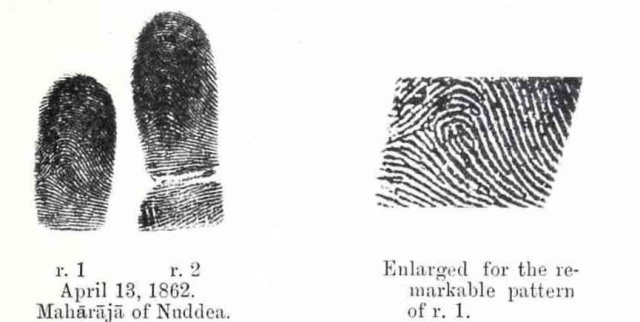 April 13, 1862.
April 13, 1862.Same day. E. Grey, B.C.S. A college friend, on my staff, afterwards Civil and Sessions Judge. He, I am happy to say, is still alive (1916), and his 'repeat' is quite good now.
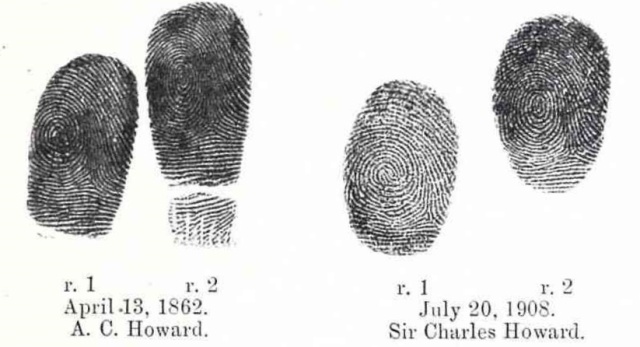 Sir Charles Howard.
Sir Charles Howard.
Same day. A. C. Howard, District Superintendent of Police, Nuddea, afterwards Assistant Commissioner at Scotland Yard, and knighted for his services there, as Sir Charles Howard. He gladly gave me a 'repeat' in London after forty-six years. It will be seen how good the persistence has been.[Pg 14]
Same day. Three other Assistant Magistrates on the unusually large staff of the district. Among these was F. K. Hewitt, B.C.S., afterwards Commissioner of Chota Nagpur. Twenty-six years later, at my request, he furnished Sir Francis Galton with the 'repeat' printed on p. 93 of his famous work 'Finger-prints' (Macmillan, 1892). I have much later repeats taken at Oxford.
Same day. Ninian H. Thomson, Judge of the Court of Small Causes. He kindly sent me a repeat twenty-eight years later from Florence, and this also appears in the same work, p. 93.
Very early in my experiments I entertained misgivings about the possibility of the impressions being forged by the professional criminals whom we had so much reason to fear. I therefore submitted some specimens to the best artists in Calcutta to imitate. Their failure sufficed to dispel all anxiety on that point. None of them come near Bewick's engravings in accuracy.
Before I left Kishnagar (Nuddea) the violence of the Indigo disturbances had been subdued, but the Courts became choked with suits for enhancement of rent upon the recalcitrant cultivators, and the sore point about the genuineness of leases, &c., became aggravated. I took courage from despair, and in my judicial capacity (if I remember right) addressed an official letter to the Government of Bengal, definitely advocating administrative action to enforce the use of 'finger-prints' by both parties as necessary to the validity of these documents.[Pg 15] Unfortunately I kept no private draft of this letter, and have lost the date, probably 1862 or 1863. It must, however, be on record, both in Nuddea and in the Calcutta Secretariat. Nothing came of it, and I took no more pains about it. But a few years ago I was pleasantly reminded by Mr. Horace Cockerell, for some time Secretary to the Government, who gave me the history of its reception, viz. that it had been deemed inadvisable, when things were quieting down, to raise a new controversy of the sort. He added that it was a matter of regret now, that no action whatever had been taken, but he pointed out that legislation would have been necessary to make the new marks admissible in evidence, and to get such a law on the spur of the moment would have been hopeless. That difficulty had certainly never occurred to me when I made the suggestion. But how weighty an objection it was is shown by the fact that it was long, even after the value of finger-prints had been established in practice, before the High Court of Calcutta, in a leading case, declared that the evidence could not be excluded, nay more, that it was cogent. This was many years before such a case in England. At the time I wrote it is quite certain that no Court in India, no pleader, no solicitor had ever recognized such signatures as these.
In 1863 I took my first furlough to England, which changed the current of my thoughts. But I found that my own people had been more interested than I had supposed by my correspondence[Pg 16] on the subject. Among my brother Alexander's papers was found after his death a letter telling him my ideas, and asking him to devise a roller of some sort, for oil-ink, better than my soft office pads.
During that and later furloughs I took no public steps about the subject. In society, of course, it was looked on simply as a hobby, attracting no more serious attention than did Bewick's fancy for engraving his thumb-mark in his day. But the warm interest shown by my own people, who had known my early troubles in India, determined me, during my last furlough, that before completing my service I would give the thing an open official trial on my own responsibility. I sailed, 1877, in the P. and O. steamer 'Mongolia', Captain Coleman, with my sister, now Mrs. Maclear, who was an enthusiast on my side. We roused attention enough on board in the Indian Ocean to obtain the finger-prints of the Captain and many of his officers, stewards, and kalāshis; also of many of the passengers, among whom I may especially mention Sir Alfred and Lady Lyall (as they afterwards became), Colonel Garrow Waterfield, and Colonel Chermside. Some thirty years later, 1908, Sir A. Lyall permitted me to take and use his repeat impression. Here are facsimiles of both, and also of Captain Coleman's, the pattern of which was thought then to deserve enlargement. Friendship, which for family reasons sprang up between Colonel Garrow Waterfield and myself,[Pg 17] led him to take special interest in my project, and I cannot doubt that he carried that with him to the Punjab, where his reputation was high. Most of the other saloon passengers were business men on their way back to the Far East, and left us at Ceylon. If any one of them had heard of the use of these marks, say in China, I could not but have been told of it. But there was not a breath of the sort. I give here a list of the remaining signatures still in my possession, in case any may meet with recognition: F. Slight, Officer of the 'Mongolia', F. A. Owen, J. Watson, R. Hawkins, F. Wingrove, O. Westphal, J. W. Malet, G. S. Lynch, Mrs. Philip. It is only reasonable, I think, to believe that such a novel and evidently useful idea would have spread by their means wherever they went. My exhibition was frequently asked for, and I always gave a duplicate of his mark to each person, and sometimes added one of my own to show the extraordinary persistence of patterns after nigh twenty years.
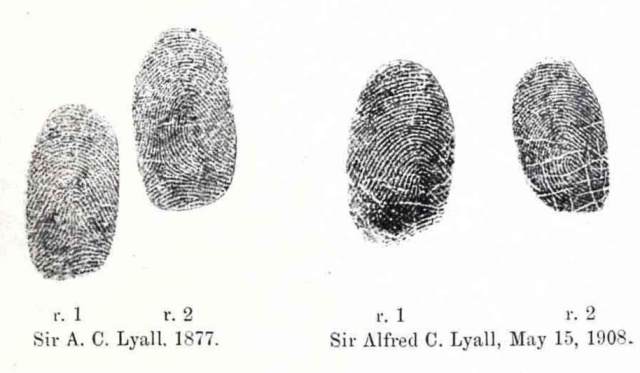 Sir Alfred C. Lyall.
Sir Alfred C. Lyall.
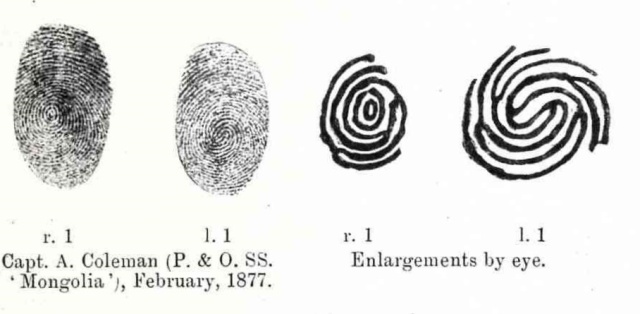 Capt. A. Coleman (P. & O. SS.
'Mongolia'), February, 1877.
Capt. A. Coleman (P. & O. SS.
'Mongolia'), February, 1877.
On my return to India, my position as Magistrate and Collector at Hooghly, near Calcutta, gave me the control, not only of criminal courts, but of the jail, and of the modern Department for Registration of Deeds of all sorts, and among minor duties the payment of Government pensions. Registration, of course, appealed most strongly to my desires, but the Sub-Registrar and his clerks had to be trained, and meanwhile the few pensioners enabled me to break the ice myself. I was not a little anxious lest, officially introduced, Hindus might take alarm for their caste. The memory of the greased cartridges of the Mutiny, so near Hooghly, was indelible. In private experiments I had never met any such difficulty, but the old lesson had been a severe one, and I thought it well, when acting officially, to take every precaution. I was careful, therefore, from the first ostentatiously to employ Hindus to take the impressions wanted; using, as if a matter of course, the pad and the ink made by one of themselves from the very seed-oil and lamp-black which were[Pg 19] in constant use for the office seals in the several departments.
The glad approval of the pensioners was a great pleasure to me, and made the other registration work astonishingly easy. The clerks took to it unhesitatingly, and enjoyed the fun of explaining the 'Sahib's hikmat'. No one ever hesitated to do as he was told, or to take away duplicates for talk at home. The process of registration at that time was regulated by a late law devised to afford the best security then possible for the genuineness of deeds, as far as attestation went. The signatures, whether in full or by caste mark, or by cross, or, in the case of women mostly, by touching the paper with the tip of the finger wetted with ink from the clerk's pen (see p. 35), were always made in the presence and under the eye of the Registrar, who, in most cases, had to rely on the sworn evidence of witnesses attesting their personal knowledge of the executant. The Registrar was, of course, responsible for using his intelligence in each case to prevent imposture. His part of the work was never impeached, that I know, in Bengal; nevertheless, fraudulent attempts did still come to light. Signatures were still denied; personations in presenting false deeds did take place, either to swindle, or, in one case, to fabricate an alibi. As long as I was at Hooghly I was quite satisfied that no will or other deed registered there with the new safeguard would ever be repudiated by the actual executant. I have had to think otherwise since then, because many[Pg 20] years afterwards a man (in another district) who had given his finger-print before a Registrar repudiated it. He was summoned to give his evidence on oath. It was found that he had cut off the joints of his fingers, hoping to defeat justice by corrupting the witnesses so as to prove that he was not the man they had recognized before the Registrar. The High Court rejected the sworn story of an accident, and confirmed the facts of the registration, with the necessary consequence to the offender for his perjury. I do not know of any other repudiation having been pressed to this bitter end in India or elsewhere. The contrast between the inherent weakness of the old law and the efficiency of the new test could not be better exemplified. This case gave the first stern blow to the foul mischief that had developed such cruel proportions in India under cover of our conservative legal habits.
The way the new safeguard was applied at Hooghly in 1877 was thus:—After the legal formalities of registration had been observed, the Registrar made the person print his two fingers on the deed, and again in a diary book which was kept by him in the office, for my own inspection rather than as evidence. It is, no doubt, preserved at Hooghly still.
It was from this book that cuttings were made at my request in 1892 by Mr. Duke, the magistrate, which formed the subject of Sir Francis Galton's volume on 'Blurred Finger-prints' (1893), to which, for its cogency in marshalling the evidence, I must refer my readers. I annex a tracing of one of his[Pg 21] enlargements, by permission of the London University, to which he left his great collection.
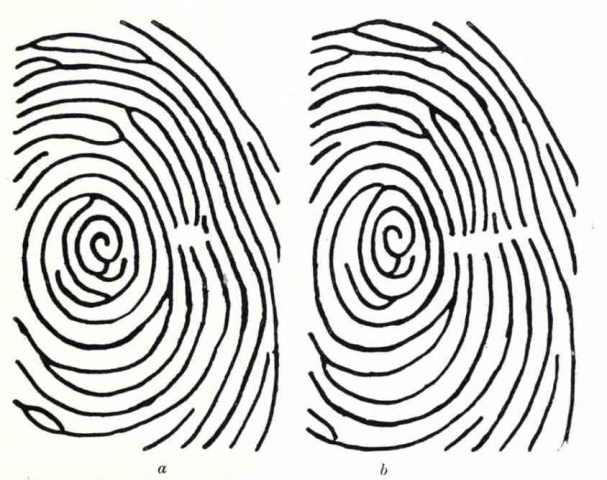 Bechā Rām Dās Adhikāri. From tracings by Mr. Galton of
enlargements, (a) Made in 1877 when registering his deed; (b) made
in 1892 for Mr. Galton.
Bechā Rām Dās Adhikāri. From tracings by Mr. Galton of
enlargements, (a) Made in 1877 when registering his deed; (b) made
in 1892 for Mr. Galton.
Another form in which I made use of the new system for public purposes was in the jail. The common device of hiring a substitute to serve out a term was not unknown, but it involved a long risk of detection. A safer but very costly, and therefore rare, device was sham death and a purchased corpse, affording comparative safety after escape. A case of this kind, carried out with the aid of an irregularly appointed doctor, was strongly suspected by me at Hooghly.[4] The precaution I [Pg 22]adopted was to take the finger-prints of each offender when passing sentence of imprisonment, both on the records of the Court and also on the warrant to the jailer.
All these processes were in full use when I left India, on the completion of twenty-five years' service, in 1878. I was by that time almost broken down in health, and more so in energy. Sir Ashley Eden, the Lieutenant-Governor, offered me a substantive Commissionership. I had already held such an appointment twice, and nothing but an honest sense of inability made me decline it now. I mention this in explanation of the slackness on my part, but for which the finger-print system would certainly have been put in force in the Registration Department, at least throughout Bengal, forty years ago. As it was, I only tried to induce the Inspector of Jails and the Registrar-General of the day to give the system a trial. Fortunately I kept an office copy of this letter, which, in reply to outside criticism, I published in 'Nature', Nov. 22, 1894, and repeat here to complete this narrative.
My dear B——, —I enclose a paper which looks unusual, but which I hope has some value. It exhibits a method of identification of persons, which, with ordinary care in execution, and with judicial care in the scrutiny, is, I can now say, for all practical purposes far more infallible than photography. It consists in taking a seal-like impression, in common seal ink, of the markings on the skin of the two[Pg 23] forefingers of the right hand (these two being taken for convenience only).
I am able to say that these marks do not (bar accidents) change in the course of ten or fifteen years so much as to affect the utility of the test.
The process of taking the impression is hardly more difficult than that of making a fair stamp of an office seal. I have been trying it in the Jail and in the Registering Office and among pensioners here for some months past. I have purposely taken no particular pains in explaining the process, beyond once showing how it is done, and once or twice visiting the office, inspecting the signatures,[5] and asking the omlah[6] to be a little more careful. The articles necessary are such as the daftari[7] can prepare on a mere verbal explanation.
Every person who now registers a document at Hooghly has to sign his 'sign-manual'. None has offered the smallest objection, and I believe that the practice, if generally adopted, will put an end to all attempts at personation.
The cogency of the evidence is admitted by every one who takes the trouble to compare a few signatures together, and to try making a few himself. I have taken thousands now in the course of the last twenty years, and (bar smudges and accidents, which are rarely bad enough to be fatal) I am prepared to answer for the identity of every person whose 'sign-manual' I can now produce if I am confronted with him.
As an instance of the value of the thing, I might suggest that if Roger Tichborne had given his 'sign-manual' on entering the Army on any register, the whole Orton case would have been knocked on the head in ten minutes by requiring Orton to make his sign-manual alongside it for comparison.
I send this specimen to you because I believe that identification is by no means the unnecessary thing in jails which one [Pg 24]might presume it should be. I don't think I need dilate on that point. Here is the means of verifying the identity of every man in jail with the man sentenced by the court, at any moment, day or night. Call the number up and make him sign. If it is he, it is he; if not, he is exposed on the spot. Is No. 1302 really dead, and is that his corpse or a sham one? The corpse has two fingers that will answer the question at once. Is this man brought into jail the real Simon Pure sentenced by the magistrate? The sign-manual on the back of the magistrate's warrant is there to testify, &c.
For uses in other departments and transactions, especially among illiterate people, it is available with such ease that I quite think its general use would be a substantial contribution towards public morality. Now that it is pretty well known here, I do not believe the man lives who would dare to attempt personation before the Registrar here. The mukhtears[8] all know the potency of the evidence too well.
Will you kindly give the matter a little patient attention, and then let me ask whether you would let me try it in other jails?
The impressions will, I doubt not, explain themselves to you without more words. I will say that perhaps in a small proportion of the cases that might come to question the study of the seals by an expert might be advisable, but that in most cases any man of judgement giving his attention to it cannot fail to pronounce right. I have never seen any two signatures about which I remained in doubt after sufficient care.
Kindly keep the specimens carefully.
Yours sincerely,
I received one answer, but its tenor was not so encouraging as I had hoped. I was out of heart, and did not press my request.
How much all this was regretted afterwards by [Pg 25] others I must in simple justice record. It came about so quietly and so honourably that it is only now that I feel myself free to say publicly how deeply I was touched. My first substantive Commissionership had been given me by Sir George Campbell, to whose house I was not long after brought back in a dying condition from malarial fever. Sir George and his private secretary, Mr. Luttman Johnson, took us, my wife and myself, into the tenderest care. Years afterwards, in 1906, the latter befriended me in the kindliest manner at the annual I.C.S. garden-party, which I but rarely attended, and invited me to dine with him that evening. It was a party of seven or eight, and the next to arrive were Sir James and Lady Bourdillon. His name, when our host introduced us, I only recognized as lately Acting Lieutenant-Governor of Bengal. To my great surprise, before our hands parted, he told me how often he had wished to meet me, to express his constant regret at having let my suggestion slip through his hands when he was Registrar-General. He remembered my letter well, and had indeed taken action by inquiry concerning my doings in his department, but for some reason he had lost sight of the matter. Needless to say, we became the firmest of friends on the spot, and I had the pleasure of a visit from him afterwards at Oxford. It is some years now since he and Mr. Luttman Johnson died. None of us, as far as I know, has ever spoken of this fine act of Sir James's except in strict privacy.
The Inspector of Jails of 1877, Mr. Beverley, [Pg 26] afterwards a judge in the High Court of Bengal, is still alive. Writing in 1906, he says, regretfully, 'I have no recollection of writing the letter you refer to, but I know that, both as Registrar-General and as Inspector of Jails, I took great interest in the Finger-print system of identification, of which I always regarded you as the Apostle in India'. He too came to see me at Oxford after that, with one of his successors in the High Court.
I shall say more farther on in regard to my statement in this 1877 letter that 'these marks do not change in the course of ten or fifteen years'.
During my stay at Hooghly, so near Calcutta, I saw more society in my own house than in other stations, and interested my friends with the novelty of finger-printing. I give a few of their names to which special interest attaches.
Among Indian gentlemen, whose prints were taken at Hooghly in 1877, I do not know who are still living; I can only give the names of
(1) Bābu Dinonāth Pāl, of Hooghly;
(2) Bābu Lalit Mohun Singh, of Sibpur;
(3) Bābu Upendra Nārāyan Nandi, of Shāhāganj.
Of English friends still living I am allowed to reproduce the print of 1877, and its repeat in 1913, of Mr. Frank Courthope, well known in Sussex and in banking circles in London, (next page).
The next is remarkable. Captain V. H. Haggard, R.N., was a child of 2¾ years old at Hooghly, 1877. By much ingratiation I succeeded in getting a print of his whole hand, and another of three [Pg 27] fingers. In 1913, when on special duty in H.M.S. 'President', he kindly gave me (not for the first time) a repeat, this time at the age of 38. The baby print bears enlargement beautifully, and I am sure my readers will be delighted with the comparison I am thus able to lay before them.
One of the prints I value most, on personal grounds, is that of Sir Theodore Hope, at that time in the Legislative Council of India for Bombay. I grieve to say he has died since these words were written. He was one of my most honoured college friends in the old Haileybury days of 1853.
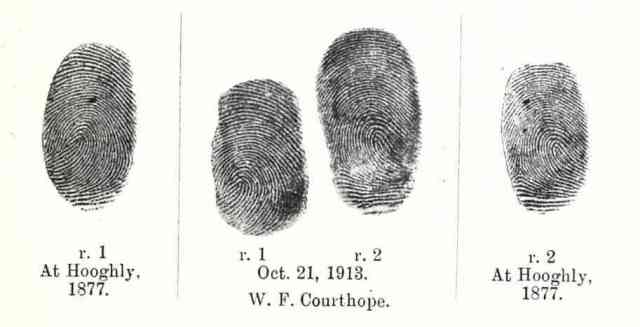 W. F. Courthope.
W. F. Courthope.
Among the last prints that I took in India were two at Mussoorie, in the Punjab Himālayas, in Sept. 1877; one of my brother Colonel J. Herschel, R.E., and one of Dr. J. F. Duthie, of the Forest Department. They are both living still, and their repeats to-day are quite good.
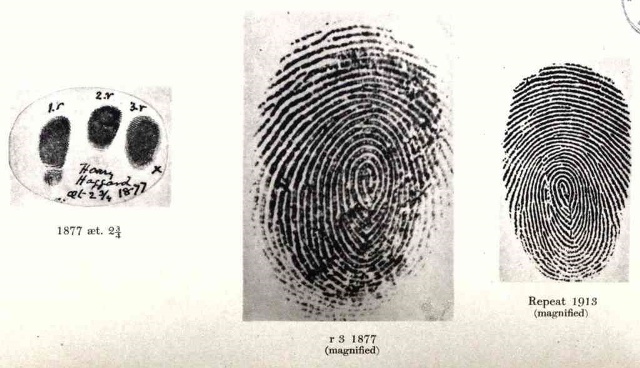 CAPTAIN V. H. HAGGARD, R. N.
CAPTAIN V. H. HAGGARD, R. N.
To return now to my letter of 1877. I was 'able to say that these marks do not change in [Pg 28] the course of ten or fifteen years'. I might have said eighteen years, for my own marks reached back to 1859; but I was steering for safety.
The conviction of the unchanging character of finger-patterns had, of course, grown on me only by degrees, as the evidence of time accumulated. Among my friends, from Nuddea days onwards, I often took second impressions, invariably drawing attention to their identity with the former ones. I never came upon any sign of change, bar accident. But such comparisons were generally limited to intervals of no more than two or three years, owing to the frequent changes of residence incidental to Indian service. As time went on it was chiefly the incessant evidence of my own ten fingers, and of my whole hand, which wrought in me the overwhelming conviction that the lines on the skin persisted indefinitely.
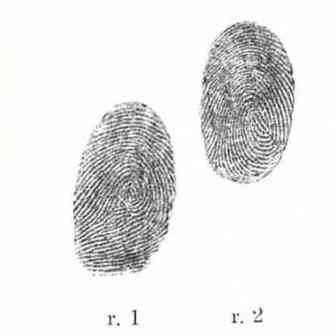 Colonel J. Herschel, Sept. 22, 1877.
Colonel J. Herschel, Sept. 22, 1877.
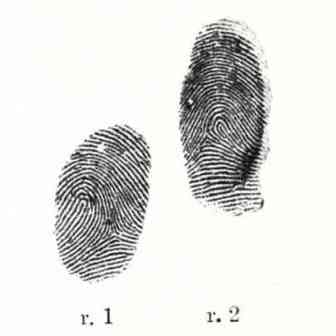 J. F. Duthie, 1877.
J. F. Duthie, 1877.
But besides my own evidence of eighteen years, I had that of my oldest college friend, William Waterfield, of almost as long. On March 31, 1877, he and [Pg 29] Mr. (afterwards Sir Theodore) Hope and Mrs. Hope were my guests at Hooghly. I took all their impressions and my own on that day, noting on Waterfield's that we compared it with his earliest print of 1860, in Nuddea, seventeen years earlier. We found the agreement, of course, complete. Here are the facsimiles.
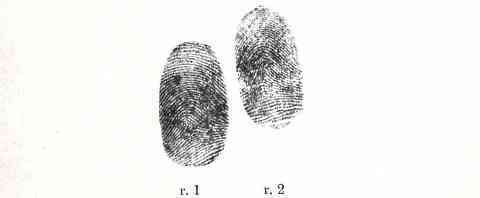 T. C. Hope, Bo.C.S., at Hooghly, 1877.
T. C. Hope, Bo.C.S., at Hooghly, 1877.
 W. Waterfield.
W. Waterfield.
If more evidence were required, I was prepared, without hesitation, to call on any person whose mark I had taken since I began. It was in fact from among those very persons, Natives as well as English, [Pg 30] that thirteen years later, at Mr. Galton's request, I obtained the repeats which, by their much longer persistence then, went so far to prove his case to universal conviction.
I close this record with a comparison between three of my own prints, taken, one in 1859, one in 1877, and the last to-day, after fifty-seven years. For length of persistence they cannot at present be matched.
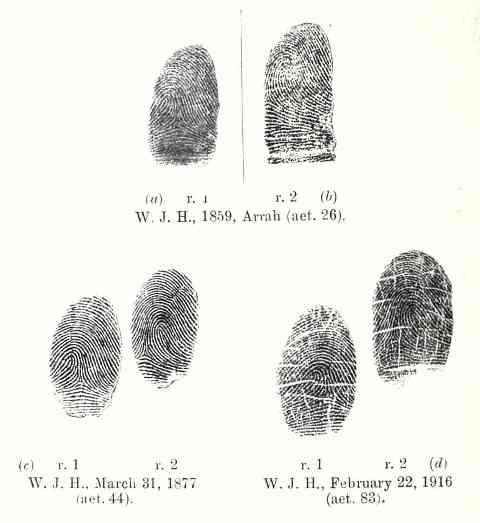 (a) (b) W. J. H., 1859, Arrah (aet. 26).
(a) (b) W. J. H., 1859, Arrah (aet. 26).It goes beyond the proper scope of this narrative, but I cannot refrain from offering my readers here [Pg 31] a striking instance of the almost incredible persistency of atomic renovation that takes place in the pads of our fingers, in spite of their being more subject to wear than any other part of the body. The first was taken at the age of 7¾; the next, for Mr. Galton, nine years later. In 1913 my son was in Canada when I asked him to send me several repeats. Every print showed the minute tell-tale dot which Mr. Galton's sharp eye had noticed twenty-two years before. No doubt it was a natal mark. It has anyhow already persisted for thirty-two years.
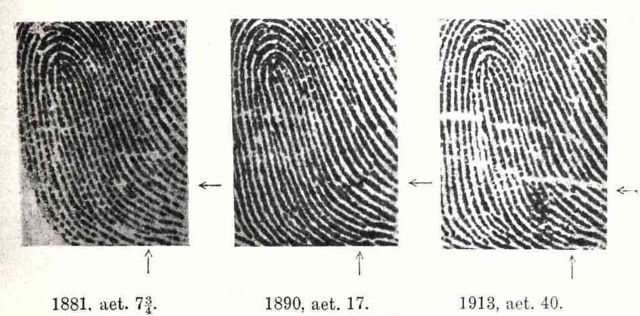 A. E. H. Herschel, r. 3.
A. E. H. Herschel, r. 3.
When I speak of the 'discovery' of finger-prints nigh sixty years ago, I should wish to be understood correctly. I cannot say that I thought of it as such until Mr. Galton examined old records in search of earlier notices of the subject. What he found had been beyond my ken, and I never inquired for myself. The fascination of experiments and the impelling object of them were all I cared about. Had it been otherwise I should have had an open field for egoism to any extent, for no one questioned the novelty of the thing.
The time that has elapsed since Galton's inquiries, without any material addition to his ascertained facts, justifies me, I venture to think, in speaking of my work as the 'discovery' of the value of finger-prints.
I proceed to show what has been brought to light from other sources.
Of modern cases the first known is that of Thomas Bewick. He was a wood-engraver, as well as an author, and had a fancy for engraving his finger-mark. He printed, as far as I can ascertain, only three specimens, by way of ornament to his books.
1. 1809. 'British Birds', p. 190. The impression of the finger appears as if obliterating a small scene [Pg 33] of a cottage, trees, and a rider, but the paper between the lines of the finger is almost all clean.
2. 1818. The 'Receipt'; of which, by Mr. Quaritch's favour, I possess one. This is, beyond all possibility of doubt, quite free from any tooling. How it was transferred to paper in those days (of which there is an indication) I am unable to say, but for his purposes it was an original 'finger-print' of Thomas Bewick. Even the fine half-tone process of this facsimile cannot reproduce its delicacy.
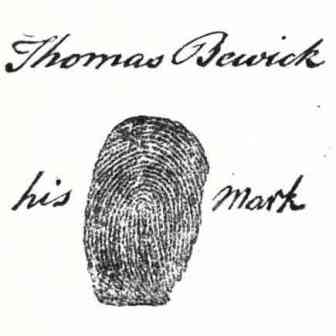 Thomas Bewick his mark
Thomas Bewick his mark
3. 1826. Memorial Edition of Bewick's Works, 1885, on the last page of the last volume, under a letter dated 1826, in which he rates some one for copying his woodcuts. When I saw it at the British Museum some years ago I thought it showed toolwork.
These three seem to be all the specimens now available, and they are from three different fingers, of which two are certified to be his own.
Gathering that Mr. Quaritch was exceptionally [Pg 34] familiar with Bewick's life, I told him that I wished to leave no stone unturned to do ample justice to him, if he was known to have done anything more than appears above. Mr. Quaritch took the matter up very kindly, and finally informed me that he had been unable to trace any writing of Bewick's concerning these prints. There seems, therefore, no evidence that he ever took impressions of any finger but his own. Now it is true that no one of observant habits, and least of all an engraver, could fail to perceive the peculiarities of his own finger. The brick-makers of Babylon and Egypt, and every printer since fingers were dirtied by printer's ink, must have noticed them. But it is a long step from that to a study of other men's marks, with a view to identification. What Bewick certainly did do might easily have led him to such a study, but it looks as if he was satisfied with recognizing his own mark.
Remembering, as I have already said, how one of his marks had struck my fancy as a boy, I am disposed to believe that, all unwittingly, I was guided to seize upon a thread which Bewick had let fall.
Five years after Bewick, Johannes Purkinje, of Breslau, in 1823, read an essay which has been found and examined by Mr. Galton, and partly translated on p. 85 of his 1892 work. Purkinje carried his study of the patterns on fingers beyond all comparison with Bewick's use of them, of whose existence indeed he could hardly have been aware. He [Pg 35] worked hard on them for a scientific (medical) purpose. It seemed to me strange that, going so far as he did, he had not hit upon our idea. To satisfy myself I read his work through in 1909. The very last sentence in it seemed to strike a light. Referring to 'the varieties of the tonsils, and especially of the papillae of the tongue, in different individuals' (no mention of fingers), he finishes the sentence and his essay by saying: 'from all which [varieties] sound materials will be furnished for that individual knowledge of the man which is of no less importance than a general knowledge of him is, especially in the practice of medicine.' A fine conclusion indeed, and a stimulating; but no part of his essay conveys an inkling of identification by means of any of the individual varieties on which he always lays stress, not even his pioneer work in the classification of the markings on fingers.
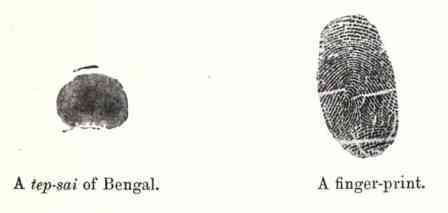 A tep-sai of Bengal.
A finger-print.
A tep-sai of Bengal.
A finger-print.
The common way for illiterates to sign is to wet the tip of one finger with ink from a pen, and then touch the document (leaving a small black blot) where we touch a wafer. The mark [Pg 36] so made is called 'tep-sai', 'tep' meaning 'pressure' by touch or grip, and 'sai' meaning 'token' (I do not know the etymology). I ask my readers now to compare the 'tep-sai' with the 'finger-print' alongside it, and to say whether the tep-sai could afford any means of identification by comparison with another blot from the same finger. Illiterates who can hold a pen make a cross, as we do, called 'dhera-sai'; others, more ambitious, indicate their caste by symbols. For the interest of the thing I give some tracings from a collection of such caste-marks which I had made for this purpose when I was Magistrate of Midnapore in 1865.
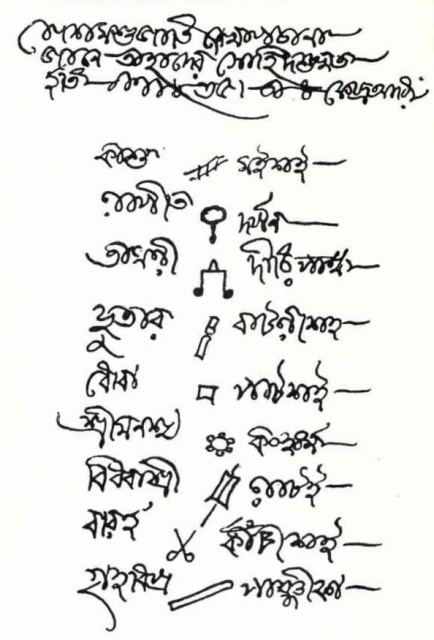
1. Cultivator; a harrow. 2. Barber; a mirror. 3. Shop-keeper; scales. 4. Carpenter; a chisel. 5. A Washerman's board. 6. Female; a bracelet. 7. Widow; a spindle. 8. Caste uncertain; scissors. 9. Family Priest; an almanac roll.
When I was introducing actual registration I asked the principal member of my Bar to give me his opinion about the new marks. His answer was as follows (the English is of course his own):
Dear Sir,
I have examined the impressions made in these papers, and I think each can be distinguished from the others. There are also so many peculiarities in each impression that it cannot be forged, and I think it would be a preventive to forgery if all documents, specially by females, or males who do not know to read or write, would contain impressions by fingers.
Yours faithfully,
I value this letter highly, for Eshan Chundra was [Pg 38] Government Pleader at Hooghly, and in frequent request in Calcutta. No native lawyer of his large practice could have written thus if he had ever known of this method of signature before.
Trustworthy information in my hands is to the effect that attestations by the finger in China are like Bengali tep-sais, and nothing more.
The nearest approach to our use of finger-prints that I have found in China came to hand thus:
An Oxford friend, Mr. Bullock, subsequently elected Professor of Chinese, had been interpreter to the Legation in Peking. Talking with him about the methods of signing deeds in China, he told me that the finger-tip (not finger-print) method was in ordinary use, but he was careful to point out also that to his knowledge ever since he went to Peking, about 1868, Chinese bankers had been in the habit of impressing their thumbs on the notes they issued; and he had no doubt the custom was much older than that. This was startling, but he kindly procured for me the bank-note which I here show in facsimile; with it came this explanation of such thumb-marks, given by his friend in China:
'They are imprinted partly on the counterfoil and partly on the note itself, so that when presented its genuineness can be tested at once.'
That is, they play the part of what is technically called the 'scroll' in our cheques.
 A CHINESE BANK NOTE, 1898
A CHINESE BANK NOTE, 1898
My readers may accept it that the ink used was [Pg 39] the same Indian ink with which the Chinese characters on the note were written. That is the unhesitating judgement of such an expert as Mr. Galton, who examined it. The difference between a water ink and printer's ink for identification is enormous. Blood on the fingers has occasionally left impressions that fortunately sufficed to reveal the murderer; but, as a rule, wet fingers leave only smudges as useless as this one. It is quite certain, therefore, that no one in the habit of impressing his thumb-mark as this banker did, would use water ink, if he depended on recognizing it as his own. In short, the smudge on the bank-note was placed there in order to identify the two parts of a piece of paper after severance, not to prove who placed it so. My readers may see what exquisite delicacy of detail can be obtained by printer's ink, when so desired, if they will examine a fine skin impression with a magnifying-glass; even the pores along the ridges can be seen as white dots. For practical purposes, however, such extreme delicacy as this is not needed.
This difference of ink suggests a further remark. The Chinese have used printer's ink for ages. If they aimed at identification they would surely have discovered its great value for clear impressions, and its use could never have died out. On the other hand, a method of identification depending on water ink could never have survived for such strict work as our finger-prints. On the palm of the hand it can give a fairly good impression for such simple [Pg 40] identification as is wanted (say) for passports, because the large creases will obviously be those of the bearer of the passport, or as obviously not. These lines of the palm, so well known in palmistry, are as clear to a man as the shape of his hand, while those on the pads of his own fingers are scarcely noticed even now by one man in a million. The science of identification by means of the pads cannot, in my opinion, date farther back than 1858, when I happened to use oil-ink, which was not used for tep-sais.
The ablest defence of the claims of antiquity that I have seen is by a Japanese writer, Kumagusu Minakata, whose letter to 'Nature', Dec. 27, 1894, appears to be as exhaustive as it is able; but I hope that this paper will satisfy him that the finger-print system of our day has no connexion with the methods he describes. The 'nail-marks' of which he speaks must be utterly useless for identification; yet he treats all manner of impressions alike, and tells us indeed that they are all known by the one name of 'hand-mark'. I fear that he has failed, like some other writers,[9] to see the definite force of the word 'identification' in the finger-print system. It means that if a man can be indicated whose finger-print agrees with that on a document, he is identified with the man who put that one there. That is all we want. But it will be seen that there must be two [Pg 41] impressions at least, that will bear comparison, to constitute 'identification'.
None of the writers who have undertaken the defence appears to perceive this need of a second impression if the issue of identity turns on any kind of finger-mark. Repudiations cannot have been rare; tribunals must occasionally have been invoked; yet no instance is quoted of decision by demand for a second impression.
It seems then that these marks were not made, as ours are, expressly to challenge comparison; that, in fact, they offer no points for comparison.
In conclusion, it is hard to believe that a system so practically useful as this could have been known in the great lands of the East for generations past, without arresting the notice of Western statesmen, merchants, travellers, and students. Yet the knowledge never reached us.
[1] Till 1857 the East India Company's College.
[2] 'Finger-prints' (Macmillan, 1892), p. 26.
[3] See Appendix.
[4] I had him dismissed soon after for a different offence.
[5] The words 'signature', 'sign-manual', 'seal', were used indifferently in this letter for 'finger-print'.
[6] Clerks.
[7] Man in charge of stationery.
[8] Solicitors.
[9] I include a too brief notice of the subject by Professor Giles of Cambridge, in his recent work 'Civilization of China', p. 118, and an article in the 'Nineteenth Century' of December 1904.
End of the Project Gutenberg EBook of The Origin of Finger-Printing, by
William J. Herschel
*** END OF THIS PROJECT GUTENBERG EBOOK THE ORIGIN OF FINGER-PRINTING ***
***** This file should be named 34859-h.htm or 34859-h.zip *****
This and all associated files of various formats will be found in:
http://www.gutenberg.org/3/4/8/5/34859/
Produced by Eric Hutton and the Online Distributed
Proofreading Team at http://www.pgdp.net
Updated editions will replace the previous one--the old editions
will be renamed.
Creating the works from public domain print editions means that no
one owns a United States copyright in these works, so the Foundation
(and you!) can copy and distribute it in the United States without
permission and without paying copyright royalties. Special rules,
set forth in the General Terms of Use part of this license, apply to
copying and distributing Project Gutenberg-tm electronic works to
protect the PROJECT GUTENBERG-tm concept and trademark. Project
Gutenberg is a registered trademark, and may not be used if you
charge for the eBooks, unless you receive specific permission. If you
do not charge anything for copies of this eBook, complying with the
rules is very easy. You may use this eBook for nearly any purpose
such as creation of derivative works, reports, performances and
research. They may be modified and printed and given away--you may do
practically ANYTHING with public domain eBooks. Redistribution is
subject to the trademark license, especially commercial
redistribution.
*** START: FULL LICENSE ***
THE FULL PROJECT GUTENBERG LICENSE
PLEASE READ THIS BEFORE YOU DISTRIBUTE OR USE THIS WORK
To protect the Project Gutenberg-tm mission of promoting the free
distribution of electronic works, by using or distributing this work
(or any other work associated in any way with the phrase "Project
Gutenberg"), you agree to comply with all the terms of the Full Project
Gutenberg-tm License (available with this file or online at
http://gutenberg.org/license).
Section 1. General Terms of Use and Redistributing Project Gutenberg-tm
electronic works
1.A. By reading or using any part of this Project Gutenberg-tm
electronic work, you indicate that you have read, understand, agree to
and accept all the terms of this license and intellectual property
(trademark/copyright) agreement. If you do not agree to abide by all
the terms of this agreement, you must cease using and return or destroy
all copies of Project Gutenberg-tm electronic works in your possession.
If you paid a fee for obtaining a copy of or access to a Project
Gutenberg-tm electronic work and you do not agree to be bound by the
terms of this agreement, you may obtain a refund from the person or
entity to whom you paid the fee as set forth in paragraph 1.E.8.
1.B. "Project Gutenberg" is a registered trademark. It may only be
used on or associated in any way with an electronic work by people who
agree to be bound by the terms of this agreement. There are a few
things that you can do with most Project Gutenberg-tm electronic works
even without complying with the full terms of this agreement. See
paragraph 1.C below. There are a lot of things you can do with Project
Gutenberg-tm electronic works if you follow the terms of this agreement
and help preserve free future access to Project Gutenberg-tm electronic
works. See paragraph 1.E below.
1.C. The Project Gutenberg Literary Archive Foundation ("the Foundation"
or PGLAF), owns a compilation copyright in the collection of Project
Gutenberg-tm electronic works. Nearly all the individual works in the
collection are in the public domain in the United States. If an
individual work is in the public domain in the United States and you are
located in the United States, we do not claim a right to prevent you from
copying, distributing, performing, displaying or creating derivative
works based on the work as long as all references to Project Gutenberg
are removed. Of course, we hope that you will support the Project
Gutenberg-tm mission of promoting free access to electronic works by
freely sharing Project Gutenberg-tm works in compliance with the terms of
this agreement for keeping the Project Gutenberg-tm name associated with
the work. You can easily comply with the terms of this agreement by
keeping this work in the same format with its attached full Project
Gutenberg-tm License when you share it without charge with others.
1.D. The copyright laws of the place where you are located also govern
what you can do with this work. Copyright laws in most countries are in
a constant state of change. If you are outside the United States, check
the laws of your country in addition to the terms of this agreement
before downloading, copying, displaying, performing, distributing or
creating derivative works based on this work or any other Project
Gutenberg-tm work. The Foundation makes no representations concerning
the copyright status of any work in any country outside the United
States.
1.E. Unless you have removed all references to Project Gutenberg:
1.E.1. The following sentence, with active links to, or other immediate
access to, the full Project Gutenberg-tm License must appear prominently
whenever any copy of a Project Gutenberg-tm work (any work on which the
phrase "Project Gutenberg" appears, or with which the phrase "Project
Gutenberg" is associated) is accessed, displayed, performed, viewed,
copied or distributed:
This eBook is for the use of anyone anywhere at no cost and with
almost no restrictions whatsoever. You may copy it, give it away or
re-use it under the terms of the Project Gutenberg License included
with this eBook or online at www.gutenberg.org
1.E.2. If an individual Project Gutenberg-tm electronic work is derived
from the public domain (does not contain a notice indicating that it is
posted with permission of the copyright holder), the work can be copied
and distributed to anyone in the United States without paying any fees
or charges. If you are redistributing or providing access to a work
with the phrase "Project Gutenberg" associated with or appearing on the
work, you must comply either with the requirements of paragraphs 1.E.1
through 1.E.7 or obtain permission for the use of the work and the
Project Gutenberg-tm trademark as set forth in paragraphs 1.E.8 or
1.E.9.
1.E.3. If an individual Project Gutenberg-tm electronic work is posted
with the permission of the copyright holder, your use and distribution
must comply with both paragraphs 1.E.1 through 1.E.7 and any additional
terms imposed by the copyright holder. Additional terms will be linked
to the Project Gutenberg-tm License for all works posted with the
permission of the copyright holder found at the beginning of this work.
1.E.4. Do not unlink or detach or remove the full Project Gutenberg-tm
License terms from this work, or any files containing a part of this
work or any other work associated with Project Gutenberg-tm.
1.E.5. Do not copy, display, perform, distribute or redistribute this
electronic work, or any part of this electronic work, without
prominently displaying the sentence set forth in paragraph 1.E.1 with
active links or immediate access to the full terms of the Project
Gutenberg-tm License.
1.E.6. You may convert to and distribute this work in any binary,
compressed, marked up, nonproprietary or proprietary form, including any
word processing or hypertext form. However, if you provide access to or
distribute copies of a Project Gutenberg-tm work in a format other than
"Plain Vanilla ASCII" or other format used in the official version
posted on the official Project Gutenberg-tm web site (www.gutenberg.org),
you must, at no additional cost, fee or expense to the user, provide a
copy, a means of exporting a copy, or a means of obtaining a copy upon
request, of the work in its original "Plain Vanilla ASCII" or other
form. Any alternate format must include the full Project Gutenberg-tm
License as specified in paragraph 1.E.1.
1.E.7. Do not charge a fee for access to, viewing, displaying,
performing, copying or distributing any Project Gutenberg-tm works
unless you comply with paragraph 1.E.8 or 1.E.9.
1.E.8. You may charge a reasonable fee for copies of or providing
access to or distributing Project Gutenberg-tm electronic works provided
that
- You pay a royalty fee of 20% of the gross profits you derive from
the use of Project Gutenberg-tm works calculated using the method
you already use to calculate your applicable taxes. The fee is
owed to the owner of the Project Gutenberg-tm trademark, but he
has agreed to donate royalties under this paragraph to the
Project Gutenberg Literary Archive Foundation. Royalty payments
must be paid within 60 days following each date on which you
prepare (or are legally required to prepare) your periodic tax
returns. Royalty payments should be clearly marked as such and
sent to the Project Gutenberg Literary Archive Foundation at the
address specified in Section 4, "Information about donations to
the Project Gutenberg Literary Archive Foundation."
- You provide a full refund of any money paid by a user who notifies
you in writing (or by e-mail) within 30 days of receipt that s/he
does not agree to the terms of the full Project Gutenberg-tm
License. You must require such a user to return or
destroy all copies of the works possessed in a physical medium
and discontinue all use of and all access to other copies of
Project Gutenberg-tm works.
- You provide, in accordance with paragraph 1.F.3, a full refund of any
money paid for a work or a replacement copy, if a defect in the
electronic work is discovered and reported to you within 90 days
of receipt of the work.
- You comply with all other terms of this agreement for free
distribution of Project Gutenberg-tm works.
1.E.9. If you wish to charge a fee or distribute a Project Gutenberg-tm
electronic work or group of works on different terms than are set
forth in this agreement, you must obtain permission in writing from
both the Project Gutenberg Literary Archive Foundation and Michael
Hart, the owner of the Project Gutenberg-tm trademark. Contact the
Foundation as set forth in Section 3 below.
1.F.
1.F.1. Project Gutenberg volunteers and employees expend considerable
effort to identify, do copyright research on, transcribe and proofread
public domain works in creating the Project Gutenberg-tm
collection. Despite these efforts, Project Gutenberg-tm electronic
works, and the medium on which they may be stored, may contain
"Defects," such as, but not limited to, incomplete, inaccurate or
corrupt data, transcription errors, a copyright or other intellectual
property infringement, a defective or damaged disk or other medium, a
computer virus, or computer codes that damage or cannot be read by
your equipment.
1.F.2. LIMITED WARRANTY, DISCLAIMER OF DAMAGES - Except for the "Right
of Replacement or Refund" described in paragraph 1.F.3, the Project
Gutenberg Literary Archive Foundation, the owner of the Project
Gutenberg-tm trademark, and any other party distributing a Project
Gutenberg-tm electronic work under this agreement, disclaim all
liability to you for damages, costs and expenses, including legal
fees. YOU AGREE THAT YOU HAVE NO REMEDIES FOR NEGLIGENCE, STRICT
LIABILITY, BREACH OF WARRANTY OR BREACH OF CONTRACT EXCEPT THOSE
PROVIDED IN PARAGRAPH 1.F.3. YOU AGREE THAT THE FOUNDATION, THE
TRADEMARK OWNER, AND ANY DISTRIBUTOR UNDER THIS AGREEMENT WILL NOT BE
LIABLE TO YOU FOR ACTUAL, DIRECT, INDIRECT, CONSEQUENTIAL, PUNITIVE OR
INCIDENTAL DAMAGES EVEN IF YOU GIVE NOTICE OF THE POSSIBILITY OF SUCH
DAMAGE.
1.F.3. LIMITED RIGHT OF REPLACEMENT OR REFUND - If you discover a
defect in this electronic work within 90 days of receiving it, you can
receive a refund of the money (if any) you paid for it by sending a
written explanation to the person you received the work from. If you
received the work on a physical medium, you must return the medium with
your written explanation. The person or entity that provided you with
the defective work may elect to provide a replacement copy in lieu of a
refund. If you received the work electronically, the person or entity
providing it to you may choose to give you a second opportunity to
receive the work electronically in lieu of a refund. If the second copy
is also defective, you may demand a refund in writing without further
opportunities to fix the problem.
1.F.4. Except for the limited right of replacement or refund set forth
in paragraph 1.F.3, this work is provided to you 'AS-IS' WITH NO OTHER
WARRANTIES OF ANY KIND, EXPRESS OR IMPLIED, INCLUDING BUT NOT LIMITED TO
WARRANTIES OF MERCHANTIBILITY OR FITNESS FOR ANY PURPOSE.
1.F.5. Some states do not allow disclaimers of certain implied
warranties or the exclusion or limitation of certain types of damages.
If any disclaimer or limitation set forth in this agreement violates the
law of the state applicable to this agreement, the agreement shall be
interpreted to make the maximum disclaimer or limitation permitted by
the applicable state law. The invalidity or unenforceability of any
provision of this agreement shall not void the remaining provisions.
1.F.6. INDEMNITY - You agree to indemnify and hold the Foundation, the
trademark owner, any agent or employee of the Foundation, anyone
providing copies of Project Gutenberg-tm electronic works in accordance
with this agreement, and any volunteers associated with the production,
promotion and distribution of Project Gutenberg-tm electronic works,
harmless from all liability, costs and expenses, including legal fees,
that arise directly or indirectly from any of the following which you do
or cause to occur: (a) distribution of this or any Project Gutenberg-tm
work, (b) alteration, modification, or additions or deletions to any
Project Gutenberg-tm work, and (c) any Defect you cause.
Section 2. Information about the Mission of Project Gutenberg-tm
Project Gutenberg-tm is synonymous with the free distribution of
electronic works in formats readable by the widest variety of computers
including obsolete, old, middle-aged and new computers. It exists
because of the efforts of hundreds of volunteers and donations from
people in all walks of life.
Volunteers and financial support to provide volunteers with the
assistance they need, are critical to reaching Project Gutenberg-tm's
goals and ensuring that the Project Gutenberg-tm collection will
remain freely available for generations to come. In 2001, the Project
Gutenberg Literary Archive Foundation was created to provide a secure
and permanent future for Project Gutenberg-tm and future generations.
To learn more about the Project Gutenberg Literary Archive Foundation
and how your efforts and donations can help, see Sections 3 and 4
and the Foundation web page at http://www.pglaf.org.
Section 3. Information about the Project Gutenberg Literary Archive
Foundation
The Project Gutenberg Literary Archive Foundation is a non profit
501(c)(3) educational corporation organized under the laws of the
state of Mississippi and granted tax exempt status by the Internal
Revenue Service. The Foundation's EIN or federal tax identification
number is 64-6221541. Its 501(c)(3) letter is posted at
http://pglaf.org/fundraising. Contributions to the Project Gutenberg
Literary Archive Foundation are tax deductible to the full extent
permitted by U.S. federal laws and your state's laws.
The Foundation's principal office is located at 4557 Melan Dr. S.
Fairbanks, AK, 99712., but its volunteers and employees are scattered
throughout numerous locations. Its business office is located at
809 North 1500 West, Salt Lake City, UT 84116, (801) 596-1887, email
[email protected]. Email contact links and up to date contact
information can be found at the Foundation's web site and official
page at http://pglaf.org
For additional contact information:
Dr. Gregory B. Newby
Chief Executive and Director
[email protected]
Section 4. Information about Donations to the Project Gutenberg
Literary Archive Foundation
Project Gutenberg-tm depends upon and cannot survive without wide
spread public support and donations to carry out its mission of
increasing the number of public domain and licensed works that can be
freely distributed in machine readable form accessible by the widest
array of equipment including outdated equipment. Many small donations
($1 to $5,000) are particularly important to maintaining tax exempt
status with the IRS.
The Foundation is committed to complying with the laws regulating
charities and charitable donations in all 50 states of the United
States. Compliance requirements are not uniform and it takes a
considerable effort, much paperwork and many fees to meet and keep up
with these requirements. We do not solicit donations in locations
where we have not received written confirmation of compliance. To
SEND DONATIONS or determine the status of compliance for any
particular state visit http://pglaf.org
While we cannot and do not solicit contributions from states where we
have not met the solicitation requirements, we know of no prohibition
against accepting unsolicited donations from donors in such states who
approach us with offers to donate.
International donations are gratefully accepted, but we cannot make
any statements concerning tax treatment of donations received from
outside the United States. U.S. laws alone swamp our small staff.
Please check the Project Gutenberg Web pages for current donation
methods and addresses. Donations are accepted in a number of other
ways including checks, online payments and credit card donations.
To donate, please visit: http://pglaf.org/donate
Section 5. General Information About Project Gutenberg-tm electronic
works.
Professor Michael S. Hart is the originator of the Project Gutenberg-tm
concept of a library of electronic works that could be freely shared
with anyone. For thirty years, he produced and distributed Project
Gutenberg-tm eBooks with only a loose network of volunteer support.
Project Gutenberg-tm eBooks are often created from several printed
editions, all of which are confirmed as Public Domain in the U.S.
unless a copyright notice is included. Thus, we do not necessarily
keep eBooks in compliance with any particular paper edition.
Most people start at our Web site which has the main PG search facility:
http://www.gutenberg.org
This Web site includes information about Project Gutenberg-tm,
including how to make donations to the Project Gutenberg Literary
Archive Foundation, how to help produce our new eBooks, and how to
subscribe to our email newsletter to hear about new eBooks.